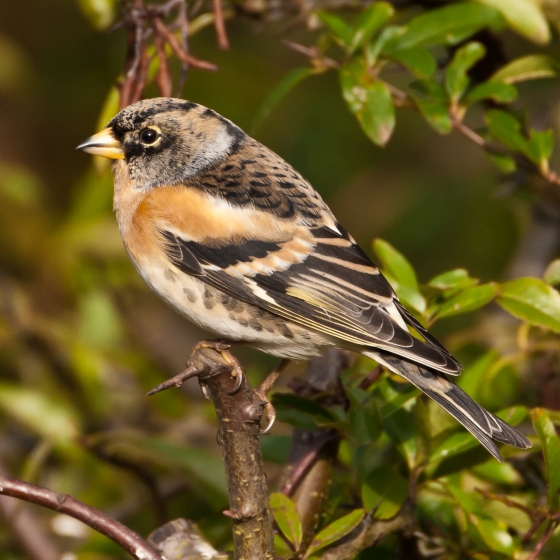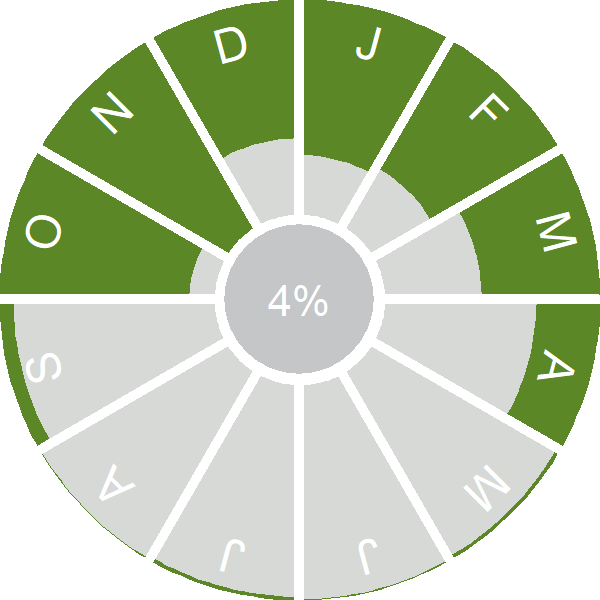Brambling

Introduction
A winter visitor to Britain & Ireland, Bramblings arrive in large numbers from Fennoscandia during the autumn and often join flocks of other finches.
An attractive bird, the Brambling can be a very welcome visitor to gardens. Bramblings will readily feed on the ground under the feeders, when their autumn-coloured plumage merges with fallen leaves so they can be hard to spot.
This is a species that can form impressively large flocks during the winter months, sometimes reaching many hundreds in the UK. However these numbers are dwarfed by record-breaking flocks of millions that have been encountered elsewhere in Europe. Such flocks are a beautiful sight in late winter as birds assume the contrasting oranges and black of summer plumage.

Key Stats
Identification
ID Videos
This section features BTO training videos headlining this species, or featuring it as a potential confusion species.
Chaffinch & Brambling
GBW: Chaffinch and Brambling
Songs and Calls
Song:
Call:
Status and Trends
Conservation Status
Population Size
Population Change
Brambling has been an extremely rare breeder in the UK since the late 1970s, with the majority of records being from northern Scotland [Eaton & the Rare Breeding Birds Panel 2023a]. It is also an abundant and widely distributed winter visitor; an apparent range expansion since the 1981–84 Winter Atlas is thought likely to be a consequence of birds responding to food availability, including in gardens, and an increase in recording effort [Balmer et al. 2013]. The species has shown a moderate decline across Europe since 1980 [PECBMS: PECBMS 2020a].
Distribution
Autumn arrivals of Bramblings from their Fennoscandian breeding grounds vary in number from year to year. In good years they are widely distributed through most of England, Wales and south, central and eastern Scotland. In Ireland they are much less widespread, being found in only 32% of 10-km squares compared to 71% in Britain. Abundance is relatively high in northeast Scotland, the Southern Uplands, East Anglia and a band running from the Welsh Marches to the Isle of Wight. Most birds depart by April but every year a few birds linger and sing. Actual breeding events are very rare and possibly declining.
Occupied 10-km squares in UK
or view it on Bird Atlas Mapstore.
or view it on Bird Atlas Mapstore.
European Distribution Map
Distribution Change
Since the 1981–84 Winter Atlas there have been apparent range expansions of 21% in Britain and 53% in Ireland. However, there are few discernible patterns in the gains and losses; this may be a consequence of birds responding to spatially variable food supplies and increased use of gardens, especially when natural food is limiting.
Change in occupied 10-km squares in the UK
or view it on Bird Atlas Mapstore.
or view it on Bird Atlas Mapstore.
Seasonality
Brambling is an autumn passage migrant and winter visitor, arriving from October and departing in April.
Weekly pattern of occurrence
The graph shows when the species is present in the UK, with taller bars indicating a higher likelihood of encountering the species in appropriate regions and habitats.

Movement
Britain & Ireland movement
Foreign locations of birds ringed or recovered in Britain & Ireland
Dots show the foreign destinations of birds ringed in Britain & Ireland, and the origins of birds ringed overseas that were subsequently recaptured, resighted or found dead in Britain & Ireland. Dot colours indicate the time of year that the species was present at the location.
- Winter (Nov-Feb)
- Spring (Mar-Apr)
- Summer (May-Jul)
- Autumn (Aug-Oct)

European movements
EuroBirdPortal uses birdwatcher's records, such as those logged in BirdTrack to map the flows of birds as they arrive and depart Europe. See maps for this species here.
The Eurasian-African Migration Atlas shows movements of individual birds ringed or recovered in Europe. See maps for this species here.
Biology
Productivity and Nesting
Nesting timing
Egg measurements
Clutch Size
Survival and Longevity
Survival is shown as the proportion of birds surviving from one year to the next and is derived from bird ringing data. It can also be used to estimate how long birds typically live.
View number ringed each year in the Online Ringing Report.
lifespan
Biometrics
Wing length and body weights are from live birds (source).
Wing length
Body weight
Ring Size
Classification, names and codes
Classification and Codes
- Order: Passeriformes
- Family: Fringillidae
- Scientific name: Fringilla montifringilla
- Authority: Linnaeus, 1758
- BTO 2-letter code: BL
- BTO 5-letter code: BRAMB
- Euring code number: 16380
Alternate species names
- Catalan: pinsà mec
- Czech: penkava jikavec
- Danish: Kvækerfinke
- Dutch: Keep
- Estonian: põhjavint
- Finnish: järripeippo
- French: Pinson du Nord
- Gaelic: Breacan-caorainn
- German: Bergfink
- Hungarian: fenyopinty
- Icelandic: Fjallafinka
- Irish: Breacán
- Italian: Peppola
- Latvian: ziemas zubite
- Lithuanian: šiaurinis kikilis
- Norwegian: Bjørkefink
- Polish: jer
- Portuguese: tentilhão-montês
- Slovak: pinka severská (ikavec)
- Slovenian: pinoža
- Spanish: Pinzón real
- Swedish: bergfink
- Welsh: Pinc y Mynydd
- English folkname(s): Mountain/Bramble Finch

